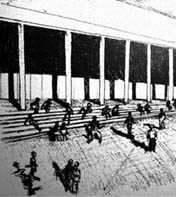

The issue of locating and planning of a hospital is reduced in principle to ab¬solutely real contingencies, i.e. to the natural conditions of an already existing urban environment. Indeed, this is expressed in the choice of an existing ur¬ban site. In such a way, the processing of the spatial and functional needs and their responding to the posed specifications take seriously into account this fundamental restriction. In short, this presupposed frame of assumptions is shaped in such a way that may be an initial starting point for the further treat¬ing of the whole issue. Another, equally important dimension that is im¬plied to the synthetic process is the adopted attitude towards this sort of ar¬chitec¬ture. Herein major concepts are treated, such as confinement, depriva¬tion, delimitation, disease, care, hospitalization, surgery, anesthesia and finally the ultimate contradiction between life and death. It is attempted that the dra¬matic dimension implied in these concepts should be spatialized up to a point; in other words, to submit the idea of a “bodily purgation” both to pa¬tients and visitors.
Besides, even the therapy for the full healing within hospital substantiates this more or less painful trial. Indeed, either as a treatment or as a surgical operation, it is accompanied more or less by the peculiar and manifold idea of pain. This idea, in conjunction with the continuous efforts of suspending it, forms an opposition that expresses firstly a pal-pable reality within hospital, which acts as a starting point in planning. Consequently, the fact that there is a strong and substantiated conceptual background, favors the creative shaping of a space that is suitable for the destined cause as well as con¬sistent to the conditions and the specifica¬tions which have been initially posed.
Supervisor: Kanarelis Theoklis
Reference Number: 100


Αt the non-operated quarry, located on the hill of goritsa at the borders of volos, near anavros, the construction of a hotel is being proposed. Τhe project is intended to supply needs of accommodation as well as cultural, social and entertainment activities, while surpassing the solidified requirements of a tourist unit.
Τhe new building is expected to cover existing needs and also to be able to constitute part of everyday life for the citizens of volos, creating a landmark of growth of activities, close to the place of residence and work, broken away with a particular way from the urban landscape. Τhe distance from the compact built space of volos is basically optical as this interruption by the hill of goritsa achieves the perceptual detachment of the visitor from it.
Τhe changes at the way of accommodation and work influence at the same time the structured space and the spatial needs of the buildings. Τhe demands for the provision of residences for indefinable period interval presuppose the creation of apartments suitably shaped. Τhe independence of spaces and movements achieve a diverse use of the building both from the tenants and the visitors of the city.
Τhe intervention is summarised in a basic movement: the creation of an upright surface which is placed almost vertically to the level of the extraction. Αt this solid the spaces of accommodation are placed, whereas the communal spaces are developed in a horizontal formation that follows -the incline of the landscape wherever this is possible. Τheir form and consequently their outline is indefinable, so that the diversification from the landscape shall not be absolutely visible.
Τhe flexibility of the project and the facility of adaptation to various types of living recommends a complex of buildings capable of corresponding with the contemporary developments and οf adapting to potential future needs of the area.
Supervisor: Antonas Aristide
Reference Number: 105


Subject of the diploma project is the Pananeion Municipal Hospital of Heraklion of Crete, which is in the area inside the Enetic Walls. The building was made in 1905 and was used as the town’s hospital. In 1970 the hospital’s installation were removed in a larger space. The building was abandoned and gradually ruined. In 2004 was proposed as a scheduled building and its destruction was seld by action.
The project’s goal is the study of the elaboration for the restoration and the new use of the building. The study has two parts: the substantiation study and the proposal. At the substantiation study was made the building’s impression, the architectural analysis and the registration of the elements as well as the identification with old pictures and previous studies. The substantiation study includes the study of its history, the cell’s pathology and the construction faces. The proposal turns up from the elements of the study. The building’s new use is a centre of abused mothers and children, which provides services of hospitalization and psychological support of abused mothers and children, surgeries for the necessary exams, rooms special designed for the hospital personnel and the visitors. The proposal’s goal is the elevation of the buildings meaning for the town and the restoration of the new use based at the town needs and the building’s history and meaning.
Supervisor: Theologidou Cleopatra
Reference Number: 81


The subject of the dissertation is transforming a “new” landscape outside the city of Nicosia which will function as a landscape park. This transformation adds to projecting the Aronas hill and the Medieval castle situated upon it. The goal of this dissertation is, at the same time, the creation of a park bearing relation to the historical and natural landscape of the wider region.
In view of creating this park, a small holding is used which is situated opposite the hill at the site of “Athalassa”. This part was chosen as it has the advantage of being situated between the Athalassa Park, the Park of the Nations and the Forestry and Botamical Park while it borders a main highway axis.
This area is transformed into a park with a multitude of plants and places for entertainment. The technique of inclined levels is applied, as well as the technique of tracing, in view of creating a specific range of view for the visitor according to the vision of the candidate. The park also includes a museum where through photographs, charts and other exhibits the history of the hill is presented as well as the one of the surrounding area including archeological finds discovered there.
This park will function as a new pole of attraction as well as a reception area for visitors who will then continue with walking hikes and excursions to the forest or who will climb the hill. In addition it will serve as a public area for the nearby university campus and the new student halls.
Supervisor: Manolidis Kostas
Reference Number: 101
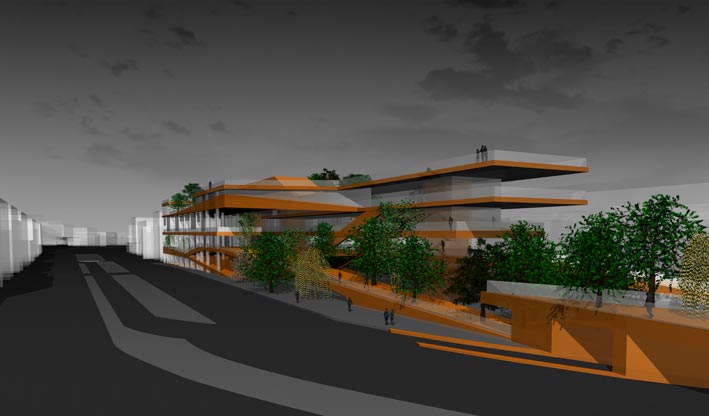

The Attic landscape has been a place of spiritual creativity, even from the ancient years. The public walk of Aristotle and his disciples (Peripatos), the Academy of Athens, the Agora all those foundations of our ancient civilization were not just buildings, they were landmarks.
Nowadays the significance of the Attic landscape has been diminished. Acknowledging the importance of hypaethral spaces for the Greek culture, this study is suggesting a new style of topology bringing together the two elements, natural and artificial landscape.
Inspired by Mr. Perikli’s Giannopoulos writing, especially by the phrasing: «living in Greece is hypaethral» a pursuit begins in order to discover and identify the available open air spaces left in the highly concentrated city structure.
The unexploited Fix building provides the inspiration necessary for the conception of the proposal presented in this paper. A vertical plaza, an open space with reference to the Attic landscape, Plaza Domino. The Fix building has always been an architectural symbol, a landmark of urban design and nowadays that icon or modern architecture is waiting for the visualization of Takis Zenetos dream of a building that can adjust to the current needs of the city, to come to life.
During the different stages of development of this study, great deal of consideration was taken on the topographic particularities of the region, like the river, the land, the tracings, the views… A variety of functions, utilities and usages are presented in this paper all of which are fully incorporated in the hypaethral scenery. The main concept of the study is based on the vegetation stream expansion, located in the area and its invasion in the industrial building of Fix.
Fix is being transformed into a contemporary public hypaethral space including facilities like theatres, restaurants, coffee shops, pools and muster points, the Fix building is ready to become a cherished part of all Athenian citizens everyday life.
Supervisor: Kotionis Zissis
Reference Number: 109
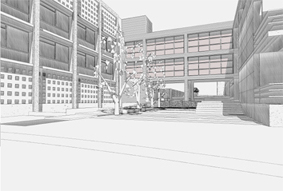

For the subject that was selected, “Multi-centre of rehabilitation and substitution for drug-addicted people.” in the area of Anavros in the municipality of Volos, the reason was given by a TV broadcasting of the journalist Tasos Kouloglou on 9/5/2005 under the title “The stigma” and on 18/5/2005 under the title “From heroin to ecstasy”. Drug problems, programmes of rehabilitation of patients in Europe, in the U.S.A., the ideal Swiss model and lastly the situation in Greece, meaning the task of OKANA and the reactions of the neighbours not only for the existing rehabilitation centres but also for the future ones were presented in these broadcastings.
The hospitalization of drug-addicted people in Greece does not come under a network, as it exists, but it does not evolve only in the big urban centres (Athens, Thessaloniki, Piraeus). The provincial towns do not have any resources and programmes in order to “cure” and inform its addictive citizens. The later are crowded in the waiting lists of these centres without knowing if they are alive in three or four years (this is the average waiting in the OKANA programmes in Greece). Thus, the creation of rehabilitation centres of drug-addicted people in provinces is an urgent and crucial need. Katerina Matsa, head of the programme “18 ANO”, states: “Provinces come in a second place in the sense that all of us can see from the various researches that come into light and from the discussions about the outcomes of these researches, that the spreading of drugs is huge in all provincial towns, especially in those with a port there are no remediate programmes”.
The term “rehabilitation” includes, apart from detoxication of the patients or the decrease of their physical lesion (addiction, decrease of the dose, substitutes etc.) their social incorporation, meaning their removal from the margin and the development of the ability to live an “organized” everyday life that does not revolve around substances. Their full incorporation can be achieved only through their communication and compromise with the society in which they live. An isolated detoxication unit just incorporates them in another kind of margin and prompts them in the “penalty of prison”.
Despite the public perception, drug-addicted patients during the period of their participation to the rehabilitation programmes show offensive attitudes (thefts, beatings etc.) in a percentage of 8% (KETHEA data). Thus, we jump to the conclusion that the rehabilitation centres that are located inside inhabited areas help users to be integrated without putting the residents into risk.
The Rehabilitation and Substitution Multi-Centre of Drug-Addicted People in the area of Anavros of the Municipality of Volos is situated inside the urban tissue of the city and moreover in an area of high rateable values and is directly connected to the hospital of the city. My intention was to design a centre that would correspond to the functional needs and standards of a programme of complete rehabilitation of the patients while the models that I studied were the Swiss prisons for drug-addicts Soengroun and “Ithaki” in Sindos in Thessaloniki.
Supervisor: Kanarelis Theoklis
Reference Number: 104




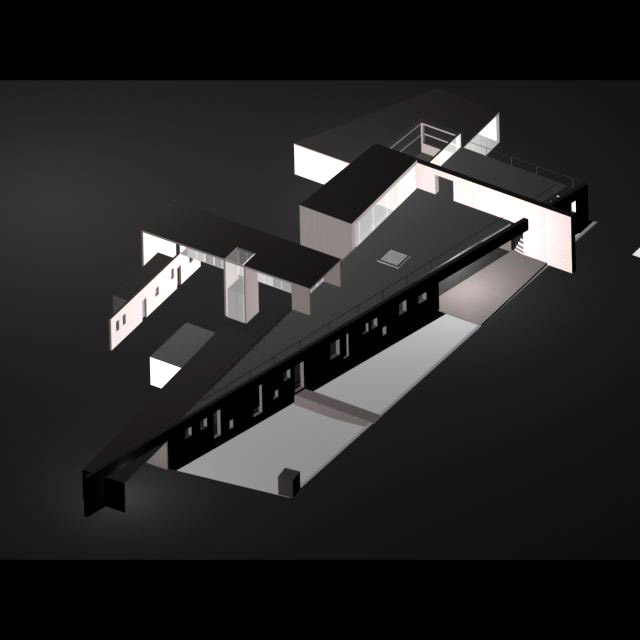

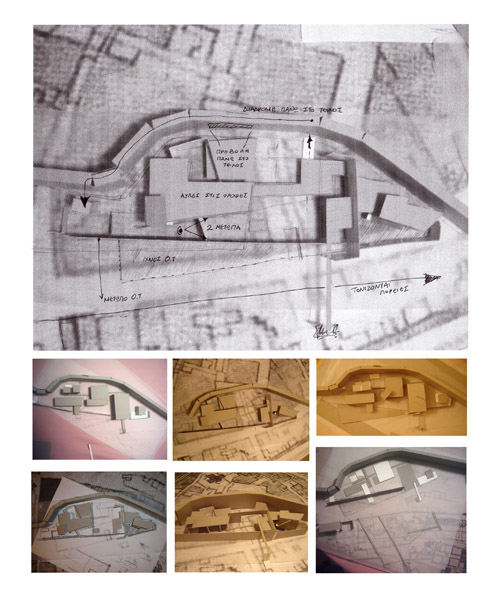

The subject of the following study is the suggestion for reformation of a destroyed area (because of the bombardments), which is situated in the preserving environment of the medieval town of Rhodes. This area belongs to the Hebrew neighborhood, known as “Ovriaki”, and it’s existence is dated from the 15th century.
The destruction of a very important part of the neighborhood, during the second world war, the continuous excavations, during the Greek administration, and the operation of the commercial and administrative center of the town, have caused a lack of interest towards that neighborhood. Today, the studying area is isolated from the rest of the town and almost without human activities.
However, the form of Ovriaki has acquired a unique architectural and city planning interest. The suggestion of studding the formation of the today square, called “Pisidorou” square, has the aim to protect the sanitation, physiognomy and the civilizing inheritance of that neighborhood.
Moreover, because of the fact that the medieval town of Rhodes is a unique settlement, it would be necessary to be made an extended approach of that area, for any kind of intervention. Also, equally important are the research and the respect of social, political and cultural legislation, that led to the formation of that particular traditional environment.
Furthermore, for the above complex procedure and the suggestion, this area was studied and were analyzed all the factors that contributed to its formation. With a suitable analysis of the unique, historical, aesthetic and city planning characteristics, two things have resulted. The first thing is a complete picture of that place and the second thing is that the historical value of that neighborhood has been appointed. Also, some facts have been found about the determination of the goals for the new intervention.
The basic plan for the development of this intervention is the enrollment of this area to the isolated continuation of the civil relationship, through the restoration of the destroyed medieval web. Also, the suggestion includes a system of functions which organize distinguished places that lead to a continuation through the alternation of typical unions. A characteristic of that intervention, as far as humans are concerned, is that the users do not follow a different path which guides their activities, but they are able to move freely to the united place, following their own path.
In conclusion, “Ovriaki” place is a basis for the study of the medieval web and a research field for its preservation and restoration. Furthermore, the enrollment of a study in a preserving environment like that, is a great challenge and a very important teaching experience.
Supervisor: Colonas Vassilios
Reference Number: 58
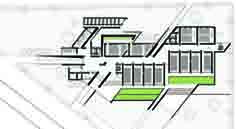

The department of Mechanic Computers and Networks of the University of Thessaly, in the city of Volos accepted its first students in the academic year 2000-2001. Since then, the department is located in a block of flats in the centre of the city, in the region of Saint Nikolao’s church that fails to meet the requirements of modern education and offer access to the particular infrastructure required by the subject matter of the Department. Since September 2003, the Department also offers a Postgraduate Program of Studies which is located in a different building in Iasonos Street.
The new building in which the Department will be moved will be designed according to the needs of the department and will be situated in the University Campus in Pedion Areos, where 5 departments of the Faculty of Engineering already function. To cover the current and future operational needs of the Department, as it is expected to accept more students every year, and respond to the lengthy procedures necessary to acquire land in the area, the building will be constructed in two phases.
The first phase of construction will take place in the triangle of Sekeri, Athens and Cheyden streets (plant yards of the Municipality of Volos) and the second phase in the triangle of Cheyden, Alamanas and Athens streets.
The object of this thesis is the design of the new building for the Department in the first phase of construction, while taking into consideration the smooth extension of the building in the second phase of growth.
The design approach of the subject was actually influenced by the subject matter of the Department itself. The internal architectural structure of computers and the continuous flow of information through their networks, was initially expressed through sketches that led in a sequence of models. The continuous flow of information in the interior of computers is translated into a continuous flow of movements through the spaces of building.
In brief, the building program includes common spaces (registrar’s, auditoriums, classrooms, a library, spaces for meetings and a coffee bar), scientific, administrative and technical personnel office spaces, laboratories, spaces for seminars and meetings, separate offices for each Department, a centre of networks for the entire University of Thessaly, mechanical installations and finally an underground parking area.
Supervisor: Trova Vasso
Reference Number: 86

